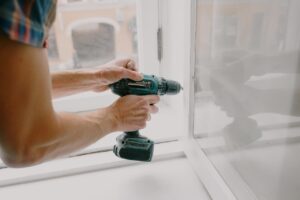
Should I fit Window Blinds myself?
In today’s world, it is possible to buy almost everything online. Window blinds and Shutters are no exception. The question that we frequently get asked is “can we fit the blinds ourselves?
“Well, the answer is yes of course but the question to really ask is how can we fit window blinds ourselves – correctly and easily?
To give an insight into what you might encounter when doing a self-fit we decided to compile the likely problems you may encounter below.
Whether fitting Roman Blinds, Roller Blinds, Venetian Blinds, Vertical Blinds, Pleated Blinds and Shutters, the first step that needs to be undertaken is measuring the window area.

Measuring Window Blinds:
This needs to be done very accurately and ideally within 1mm.
For this we sometimes do use normal tape measuring equipment but more accurately laser measuring equipment.
The full width and height of the window needs to be measured in multiple places to ensure the blind will fit.
Identifying the narrowest sections must be done and clearances added when needed to the final blind dimensions.
This may be in the recess or outside the recess.
Is the window level?
Are there any snags?
What clearances should I apply?
Are there any tiles in the recess that the blind will hit at the bottom?
How far out do the handles of the windows protrude which may catch the blind?
How high from the ground will the headrail of the blind be installed?
(New European legislation advises strict criteria for installing blinds with chains and cords due to children becoming entangled and in some cases fatal accidents have occurred by strangulation.
It is imperative that you fully understand the legal requirements for fitting blinds with cords and chains. The installed height and length of the cords and chains allowed is relative to the installed height of the headrail of the blind from the ground.)
A drawing needs to be done with all notes on.
Once you have completed the above and are confident with the final size of your blind you can order it in the design, pattern and colour of your choice.
If you are happy with selecting a colour and pattern on the internet and going with that then all well and good but would it be better to see actual swatches and samples?
Fitting Window Blinds:
When you are ready to fit you must fully understand the instructions.
Brackets will be supplied which will need to be fixed to the wall or ceiling.
The blind will clip into these brackets.
Did you opt for end fixing or top fixing brackets?
Either way you have to drill the wall or ceiling to fix them.
You will need a selection of tools depending upon what material you are drilling into.
A pistol drill with hammer function is required but if drilling into concrete then an SDS drill will be needed with dedicated drill bits.
The wall could be brick, plasterboard, wood, concrete, plastic, steel or a combination of several of those.
What drill bit? – Well this depends upon what you encounter when trying to drill the wall.
For steel you will need HSS drill bits.
For wood – wood drill bits.
For Concrete – SDS drill bits and an SDS drill.
Brick – Masonry drill bits.
It is hard to know what is in place in the wall unless you have experience drilling into lintels of various materials.
You may start off with a masonry drill and hit something it cannot drill.
You may start off with a metal drill and it instantly goes blunt!
It takes experience or a lot of trials to get the right drill for the right media in the wall first time.
Do you know which size drill you need according to what fixing and screws you intend to use?
Once you have the holes drilled, hopefully in the right places after consulting all your measurements, you now need to insert the right screw fixing or sometimes no fixing at all if directly into a steel lintel.
What do you do if there is no lintel or only plasterboard?
Is plasterboard strong enough to support the weight and operation of the blind?
What screws do I use into a steel lintel?
Getting all this right takes practice, we know because we have done it and learned by our mistakes.
Knowing what drill to use, what size, what fixings and where to fix only comes with experience in fitting blinds on a day to day basis with all types of blinds and window lintels, or in some cases no lintels.
Window Blind Adjustments
If you have now successfully fitted the blind.
Have you secured any chains and cords to the correct legal height?
Have the cords and chains been fitted with a breakaway adapter or tensioner system to prevent strangulation?
Is the blind level?
Adjusting the blinds can be done but can be a little fidgety and time consuming to get it exactly right.
 Tools you will need to fit your window Blind:
Tools you will need to fit your window Blind:
Minimum
- Hammer Drill and drill bits (Masonry, Steel and Wood drill bits)
- Steps
- Wall plugs and screws unless correctly supplied for wall type
- Screwdriver
- Measuring Tape
- Scissors
- Ideally:
- Hammer Drill and drill bits (Masonry, Steel and Wood drill bits)
- SDS Drill and dedicated masonry drill bits
- Steps or better a standing platform
- Wall plugs and screws unless correctly supplied for wall type
- Screwdrivers various
- Measuring Tape
- Laser measuring tool
- Spirit Level
- Stanley Knife
- Hoover
- Dust cloths
- Pliers
- Hacksaw
- Scissors
Our own toolboxes do comprise of many more tools than we have listed because we encounter all sorts of different mountings and materials.
We even have workshop equipment to alter blinds if needs be and make custom mitred units for bay windows.
Summing up should I fit window blinds my self:

The above is only an insight into what can be encountered when fitting window blinds. An experienced DIY person with good tools and fittings can fit the blinds and hopefully with no added complications.
For the general non-DIY person we would recommend using a local window blind supplier installer who has all the correct tools for the job. He will have the experience and speed to install them saving you time and effort.
He should also be insured to cover against any unforeseen issues which rarely happen but if you do it yourself you may not be covered. Always check that your installer is insured!
We would never recommend a DIY person trying to install Shutters. A full training course is needed even for competent installers.
